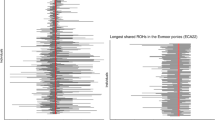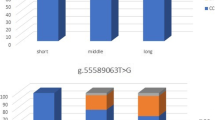Abstract
Among horses selected for speed, the racing line of Quarter Horses is characterized by high performance in sprint races, with these animals being considered the fastest horses in the world. However, few studies have investigated in more detail the polymorphisms and genes that act on this trait. The objective of this study was to analyze exomes and UTRs in regions previously associated with this trait by GWAS in Quarter Horse racehorses with contrasting maximum speed index (SImax), prospecting causal gene polymorphisms that are related to or are in strong linkage disequilibrium with racing performance. Genotypic and phenotypic records from 360 animals of the racing line of Quarter Horses, previously genotyped with an SNP chip to obtain individual genomic estimated breeding values for performance, were used for the formation and sequencing of two groups of animals with contrasting racing performance (20 animals with superior SImax and 20 with inferior SImax). Two rapid runs were performed using two pools of libraries containing 20 and 19 samples randomly chosen among the 40 samples with contrasting SIs. A total of 1203 variants (1105 SNPs and 93 InDels) were identified in 33 regions of interest obtained previously by GWAS. Twenty-nine of the polymorphisms (24 SNPs and 5 InDels) were considered to be important based on three different and independent approaches: SIFT scores classified as deleterious (< 0.05), degree of impact on the consensus region of each polymorphism, and different allele frequencies identified by Fisher’s exact test (p < 0.01) between the groups of horses with contrasting SImax. Thus, eight genes described as functional and positional candidates in previous studies (ABCG5, COL11A1, GEN1, SOCS3, MICAL1, SPTBN1, EPB41L3, and SHQ1) and nine new candidate genes (AKNA, ARMC2, FKBP15, LHX1, NOL10, TMEM192, ZFP37, FIG4, and HNRNPU), some of them with known function, were related to racing performance in Quarter Horses.
Similar content being viewed by others
References
America’s Horse Daily (2017). All about the racing American Quarter Horse. http://americashorsedaily.com/all-about-the-racing-american-quarter-horse/#.Urx8N_RDvik (accessed 13 june 2017)
Andrews S. (2010). FastQC: a quality control tool for high throughput sequence data. http://www.bioinformatics.bbsrc.ac.uk/projects/?fastqc/ (accessed 24 june 2017)
Butkiewicz M, Bush WS (2016) In silico functional annotation of genomic variation. Curr Protoc Hum Genet 88:6.15.1–6.15.17. https://doi.org/10.1002/2F0471142905.hg0615s88
Cartwright RA (2009) Problems and solutions for estimating indel rates and length distributions. Mol Biol Evol 26:473–480. https://doi.org/10.1093/2Fmolbev/2Fmsn275
Danecek P, Auton A, Abecasis G, Albers CA, Banks E, Depristo MA, Handsaker RE, Lunter G, Marth GT, Sherry ST, Mcvean G, Durbin R, 1000 Genomes Project Analysis Group (2011) The variant call format and VCFtools. BMC Bioinformatics 27:2156–2158. https://doi.org/10.1093/2Fbioinformatics/2Fbtr330
Eccles JC, Llinás R, Sasaki K (1966) The excitatory synaptic action of climbing fibres on the Purkinje cells of the cerebellum. J Physiol 182:268–296
Fisher R (1970) A statistical methods for research workers, 14.ed edn. Oliver and Boyd, Edinburgh
Godoy TF, Moreira GCM, Boschiero C, Gheyas AA, Gasparin G, Paduan M, Andrade SCS, Montenegro H, Burt DW, Ledur MC, Coutinho LL (2015) SNP and INDEL detection in a QTL region on chicken chromosome 2 associated with muscle deposition. Anim Genet 46:158–163. https://doi.org/10.1111/age.12271
Krøigård AB, Thomassen M, Lænkholm A-V, Kruse TA, Larsen MJ (2016) Evaluation of nine somatic variant callers for detection of somatic mutations in exome and targeted deep sequencing data. PLoS One 11: e0151664. https://doi.org/10.1371/journal.pone.0151664
Ledig S, Brucker S, Barresi G, Schomburg J, Rall K, Wieacker P (2012) Frame shift mutation of LHX1 is associated with Mayer–Rokitansky–Küster–Hauser (MRKH) syndrome. Hum Reprod 27:2872–2875. https://doi.org/10.1093/humrep/des206
Li H, Handsaker B, Wysoker A, Fennell T, Ruan J, Homer N, 1000 Genome Project Data Processing Subgroup (2009) The sequence alignment/map format and SAMtools. BMC Bioinformatics 25:2078–2079. https://doi.org/10.1093/bioinformatics/btp352
Lindenbaum P(2017) FixVcfMissingGenotypes. https://github.com/lindenb/jvarkit/wiki/FixVcfMissingGenotypes (accessed 16 october 2017)
Liu L, Li Y, Li S, Hu N, He Y, Pong R, Lin D, Lu L, Law M (2012) Comparison of next-generation sequencing systems. J Biomed Biotechnol. https://doi.org/10.1155/2012/251364
Lunter G, Goodson M (2011) Stampy: a statistical algorithm for sensitive and fast map** of Illumina sequence reads. Genome Res 21:936–939. https://doi.org/10.1101/2Fgr.111120.110
Meira CT, Fortes MRS, Farah MM, Porto Neto L, Kelly M, Moore SS, Pereira GL, Chardulo LAL, Curi RA (2014a) Speed index in the racing Quarter Horse: a genome-wide association study. J Equine Vet Sci 34:1263–1268. https://doi.org/10.1016/j.jevs.2014.09.003
Meira CT, Curi RA, Farah MM, Oliveira HN, Beltran NAR, Silva JAIIV, Mota MDS (2014b) Prospection of genomic regions divergently selected in racing line of Quarter Horses in relation to cutting line. Animal 8:1754–1764. https://doi.org/10.1017/S1751731114001761
Mi H, Poudel S, Muruganujan A, Casagrande JT, Thomas PD (2016) PANTHER version 10: expanded protein families and functions, and analysis tools. Nucleic Acids Res 44:336–342. https://doi.org/10.1093/nar/gkv1194
Moliterno AR, Resar LM (2011) AKNA: another AT-hook transcription factor “hooking-up” with inflammation. Cell Res 21:1528–1530. https://doi.org/10.1038/2Fcr.2011.96
Nielsen BD, Turner KK, Ventura BA, Woodward AD, O’connor CI (2006) Racing speeds of Quarter Horses, thoroughbreds and Arabians. Equine Vet J 36:128–132
Parsons MT, Whiley PJ, Beesley J, Drost M, de Wind N, Thompson BA, Marquart L, Jl H, Jenkins MA, Brown MA (2013) Consequences of germline variation disrupting the constitutional translational initiation codon start sites of MLH1 and BRCA2: use of potential alternative start sites and implications for predicting variant pathogenicity. Mol Carcinog 54:513–522. https://doi.org/10.1002/2Fmc.22116
Pereira GL, Silva JAIIV, Chardulo LAL, Faria RAS, Curi RA (2018) Genomic regions associated with performance in racing line of Quarter Horses. Livest Sci 211:42–51. https://doi.org/10.1016/j.livsci.2018.02.015
Petersen JL, Mickelson JR, Cothran EG, Andersson LS, Axelsson J et al. (2013) Genetic diversity in the modern horse illustrated from genome-wide SNP data. PLoS One 8:e54997. https://doi.org/10.1371/journal.pone.0054997
Purcell S, Neal B, Todd-Brown K, Thomas L, Ferreira MA, Bender D, Maller J, Sklar P, de Bakker PI, Daly MJ, Sham PC (2007) PLINK: a tool set for whole-genome association and population-based linkage analyses. Am J Hum Genet 81:559–575. https://doi.org/10.1086/519795
Shin D-H, Lee JW, Park J-E, Choi I-Y, Oh H-S Kim HJ, Kim H (2015) Multiple genes related to muscle identified through a joint analysis of a two-stage genome-wide association study for racing performance of 1,156 thoroughbreds. Asian-Aust J Anim Sci 28:771–781. https://doi.org/10.5713/2Fajas.14.0008
Acknowledgements
This work was supported by Fundação de Amparo à Pesquisa do Estado de São Paulo (Fapesp), São Paulo, SP, Brazil—process number: 2014/20207-1 and Roche Diagnostica Brasil Ltda for the technical training in the construction of libraries for the sequencing of exomas.
Author information
Authors and Affiliations
Corresponding author
Ethics declarations
All animal procedures were conducted in accordance with Brazilian guidelines on animal welfare and were approved by the Ethics Committee on Animal Use of the institution (FMVZ, Unesp, Botucatu, SP, Brazil) (Protocol No. 157/2014).
Conflict of interest
The authors declare that they have no conflict of interest.
Additional information
Communicated by: Maciej Szydlowski
Publisher’s note
Springer Nature remains neutral with regard to jurisdictional claims in published maps and institutional affiliations.
Rights and permissions
About this article
Cite this article
Pereira, G.L., Malheiros, J.M., Ospina, A.M.T. et al. Exome sequencing in genomic regions related to racing performance of Quarter Horses. J Appl Genetics 60, 79–86 (2019). https://doi.org/10.1007/s13353-019-00483-1
Received:
Revised:
Accepted:
Published:
Issue Date:
DOI: https://doi.org/10.1007/s13353-019-00483-1




